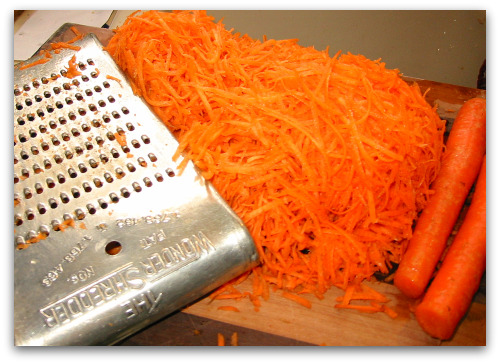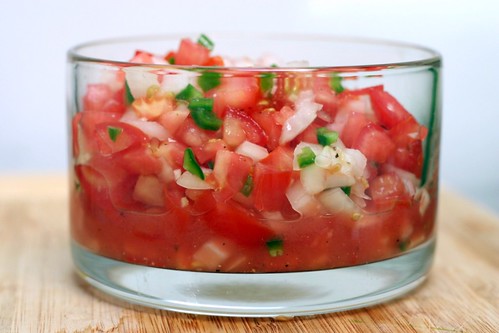
Daughter Liesl (Youngest) and I have turned our kitchen into a production center for Backpacking Food: I'm the cook, and she designs the product names and packaging (VERY IMPORTANT!) -- she's even hiding special messages in the packaging for her big sis!
Right now we're dehydrating strawberries, bananas and kiwis, and are having tons of fun inventing and making breakfast/energy bars.
So, before I forget what went into them, here is the first set of recipes.
Move over, commercial bars, we got our own brand-names
!
A-Bar: Awesome Alaska Bara baked bar containing oats, cranberries, pecans, pumpkin seeds, flax & sesame seeds.
I used Nigella's basic recipe from my last post.
1 14-oz can of sweetened condensed milk, heated on stove in large enough pan to hold rest.
2.5 c oats (rolled, but not instant)
1 c dried cranberries
1 c nuts - I used pecans
1 c seeds - I used pumpkin seeds (pepitas)
1/2 c flax and sesame seeds (save some to sprinkle on bottom of pan)
Bake for 1 hour. Let cool and cut into bars.
Critique: maybe a bit too much baking -- very dry, crunchy, like a traditional granola bar. Perfect with a cup of coffee in the morning or some cool water on the trail...
T-Bar: Truly Tropical Barcontains Oats, Mango, Apricots, cashews, almonds, almond butter, honey, crystallized ginger.
I used the 2nd recipe from last post, with the melted marshmallows. Did need the butter and added extra honey to help make it all mix and stick together.
These are uncooked bars, thus chewy -- pretty good. I predict the favorite out of this batch!
2 c rolled oats
1 c dried fruit -I used mango and apricots
1/2 c almonds and cashews
1 T sesame seeds (could have used more)
1 T crystallized ginger
3 T almond butter
5 oz marshmallows, melted
2 T butter
honey as needed -- I probably added 1/2 cup
Chop everything finely. In double boiler, melt marshmallows, butter, almond butter and honey, then mix with everything else. Press into greased pan. Let cool in frig for at least 1 hour. Cut into bars.
Critique: pretty darn good!
O-Bar: Ominous* Oat-Carob Barcontains Oats, carob, sunflower seeds, walnuts, almond butter, honey
*this name is due partially to the ominous brown color, and the fact that carob is NOT popular in this household.
Similar idea to the last: warm up the nutter butter and honey, and mix with all the other ingredients. I used my hands -- it was the easiest way to mix it all up. The carob chips melted right along with the honey, turning everything into a 1970-s looking healthnut bar.
2 c rolled oats
1 c sunflower seeds
1 c walnuts
optional: ground flax seeds (also useful for coating or hand-shaping the bars)
1 c carob chips (could use chocolate chips too!)
1/2 almond butter
1/2 c honey
more honey, maple or agave syrup -- as needed. Again, I needed something to make it all mix and stick together.
Warm up the almond butter and honey (probably needed a whole cup of honey, but not sure of the quantity actually used). Mix everything up using hands, or mixer(?), until it all sticks together. Press into a greased pan and cool in frig.
Alternatively, shape bars by hand, roll in ground flax seeds, and wrap individual bars in parchment paper or cling wrap.
Critique: I liked them, but I think I'm the only taker of carob bars in this household.
Curious to hear if any of the hikers liked them...
M-Bar: Mom's Apple Pie BarThis is based on a $4
Rawwaylife bar I tasted when I told a co-worker about my bar-making adventures, plus reading the booklet that came with the dehydrator, on loan from Eldest, and finally being put to some good use!
I made this in the Cuisinard, chopping everything right up, making this go super-quick!
1 c hazelnuts
1/2 walnuts
1 c raisins
1 c applesauce
2 t cinnamon
1 T flax seeds (whole)
1 T flax (ground)
1/4 c agave syrup (can play around with sweeteners: honey, maple, etc)
Chop nuts. Add all the other ingredients and blend them up. Spread on the fruit-leather tray of dehydrator, and dry at 135 F for approx 6 hours, according to instruction booklet (NOTE: it's been in there 11 hours now, and still not done!!! -- let's just say "drying time varies").
Critique: A nice break from the oats-centered bars (this has no oats at all -- just fruit and nuts!)
I probably could have upped the cinnamon. I liked the chewy fruit-leatheriness. Probably the least messy (at least crumb-wise) to eat right in the sleeping bag!
That's as far as we've gotten so far, but we've got lots more ideas:
B-Bar: Bravo Blueberry Barsimilar to A-Bar or T-bar: another oats, nuts and dried fruit bar.
P-Bar: Perfect Pumpkin BarI was thinking of something similar to the Apple-Pie fruit leather, starting with a can of pumpkin, adding pumpkin seeds, raisins, honey and some pumpkin spices (cinnamon, cloves), then drying in dehydrator.
P-O-Bar: Pecan-Orange Bar/ a.k.a. "Southern Belle"Here I was thinking of another fruit-leather-type bar, starting with pecans, adding concentrated orange juice, candied orange peel, dried apricots, honey, then drying in dehydrator.
Can't wait to mail them to California (I'm sure over half the ingredients were grown in California!) and find out if they pass "muster" on the PCT!
 A holiday feast has to have all the major colors represented:
A holiday feast has to have all the major colors represented:

























